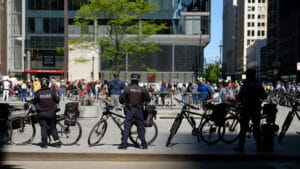And the best ways to solve them
We’ve all heard the Black Friday stories of fist fights breaking out in aisles of the local big-box retailer. To the average person, such stories are humorous. But to retail business owners, they are a cause for concern. Yet, such glaring examples hardly scratch the surface of the problems facing the retail industry.
One survey published by the National Retail Federation (NRF) illustrates this point. The survey found that retailer’s concerns about threats have increased significantly in the past 5 years.
Such concerns are not without merit. For instance, according to the survey, shrink—retail loss due to internal and external theft and fraud—resulted in retail losses of over 60 billion dollars in 2019. This figure represents a 1.4% annual increase from the previous year.
But what is driving this increase and what can be done about it?
Let’s take a look at the Top 5 problems facing the retail industry.
- Supply Chain Disruption
During the Covid-19 pandemic, reliance on e-commerce for shopping is at an all time high. Digital transactions seem less vulnerable to shrink in theory. Yet, the complexity in supply chains exposes vulnerability to fraud and product loss.
Retailers may rely on vendors thousands of miles away to ship products to customers. These shipments leverage public and private delivery organizations to ensure successful product distribution. Thus, a delivery disruption can result in revenue loss.
Further, when customers decide to return products, packages must be shipped back to the original distributor. The complexity of this supply chain can result in revenue loss as packages are lost and customers make fraudulent claims that are difficult to track.
So what can businesses like yours do to address the first of five problems facing the retail industry?
The most important step is to devise a plan with stakeholders. Include suppliers, distributors, and delivery services in the conversation. Get all parties on board and create a formal playbook.
Having a procedure in place, with roles and responsibilities clearly defined will ensure the smooth operation of the supply chain as you navigate the ever-changing retail landscape.
Next, we will consider the second problem facing the retail industry.
- E-commerce Fraud
In addition to shrink due to supply chain complexity, the overall digital landscape presents a challenge for many retailers.
As consumers increasingly rely on online transactions, the risk of fraudulent claims increases. For example, false claims of lost or damaged items are not uncommon. And some may request a replacement for an item that is undamaged.
Due to these risks, it’s essential that organizations develop a procedure to address customer claims. This process should require evidence to support claims of lost or broken goods. For instance, a photograph of the damaged item or a verification from a delivery service in the case of lost items.
Having a well defined supply-chain strategy in place (see above) will reduce such fraudulent claims. Additionally, creating a dedicated e-commerce loss-prevention (LP) team can reduce shrink due to fraud. Integrate this team with supply chain management to ensure fidelity at every step of the investigative process.
Let’s explore another concern for retailers.
- Customer Data Theft
As we approach the holiday season, the risk of cybercrime increases. Concerns such as phishing and sniffing become more pressing during this time of the year.
Phishing can take on many forms. For instance, phishers may create fake websites intended to elicit consumer credit card information. Be wary of this problem and consider keeping an eye out for dummy sites resembling your organization’s site. Phishers may also send emails asking for customer information.
Sniffing, on the other hand, can be more insidious. As skilled cybercriminals insert code into payment pages to lift customer data during transactions. This may be difficult to track and often requires the expertise of a cybersecurity professional. Consider hiring an expert, as cybercrime is one of the more serious problems facing the retail industry.
You might also inform customers of these risks by sending out an educational email. Simply by priming customers with relevant information, they will be less likely to fall prey to cyber attacks. This is a low-cost strategy with the potential to save your organization money.
Let’s pivot to threats to your physical properties.
- Organized Retail Crime
The threat of e-commerce crime is real in the 21st Century. Yet, threats to traditional brick-and-mortar retailers still exist and represent one of the problems facing the retail industry.
Organized retail crime (ORC) is a blanket term describing criminal acts performed by organized groups. Often, such groups consist of a leader who researches the value of items on the market, and a group of followers who shoplift the items that are most valuable.
Recent criminal justice reforms may contribute to spikes in ORC, as reported by the NRF. As the consequences for these crimes are diminished, criminals see ORC as a low-risk opportunity to make money.
Unfortunately for your business, not all of these actors are as incompetent as Marv and Harry from the Home Alone series. And it may take more than an 8-year-old with a house full of hardware to apprehend them.
So how can you protect your business from ORC? It starts with establishing a well-trained LP team. These individuals may pose as customers to monitor activity within the store. They monitor video feeds and conduct internal investigations, keeping a close eye on employees suspected of theft and/or fraud.
Finally, consider hiring outside security personnel. A well trained security team can go a long toward reducing the problems facing the retail industry.
Let’s look at the final concern for retail organizations.
- Lack of Security and Law Enforcement Personnel
National unrest has emerged during the global pandemic. With law enforcement resources challenged due to the current cultural moment, it’s important to keep an eye on related trends.
Know the law enforcement terrain in your region. Keep an open dialogue with local police and security agencies to survey the need to step-up internal LP systems if necessary.
If your business is more susceptible to theft due to law enforcement budget cuts, dedicate the necessary resources to LP. Additionally, design a threat assessment to anticipate threats to your organization before they become a reality.
Planning can go a long way. But having boots on the ground can bolster your company’s future and help prevent loss.
Consider hiring a security team to protect your hard-earned assets.
Conclusion
Here we’ve considered five problems facing the retail industry. As we approach the holiday season, it is imperative that retailers prepare for the possibility of shrink.
It’s always fun to recount Black Friday hijinks, but as a business owner, you are aware that the threats facing your business are not always so humorous. And during the global pandemic, you face an unprecedented holiday landscape.
Consider preparing for the problems outlined in this article, and adjusting your business strategy where you can. For instance, offer promotions to encourage curb-side pickup to increase sales at brick-and-mortar stores. This will help you avoid some of the pitfalls of e-commerce.
At Chesley Brown, we understand that planning for the unknown can be daunting. That’s why we’ve built a framework that enables businesses to navigate and anticipate risk before it becomes a crisis. We are here to manage risk so you don’t have to.
Posted by:
Sign up!
For industry-leading guides and analysis sign up for our blog below.
Latest News
Holiday Safety Tips
3 practical ways to stay safe in 2020 We’ve all heard humorous holiday tales. They make for great entertainment around the table during a turkey dinner. You know the stories–e.g., the time Uncle Frank fell…
Read MoreElection Day: Planning for Civil Unrest
Protecting your business in the event of election day civil unrest requires planning. Here we discuss four proven strategies for Civil Unrest
Read MoreThe Transformational Power of Threat Assessments
Ignoring Risk won’t make it go away Cyber crime is one of the most insidious threats facing businesses. As reported here, more than 50% of businesses have suffered cyber attacks–70% of them being small to…
Read More3 Practical Strategies to Protect Your Small Business During Covid-19
October 15, 2020 / Justin Hayes Ensure the Future of Your Company Small to medium-sized enterprises (SMEs) comprise a massive portion of American industry. In fact, 99% of all businesses have less than 500 employees;…
Read MoreThe Anatomy of a Crisis Management Plan
4 key strategies to protect your business against risk By Justin Hayes No executive expects a crisis to strike. But every day organizations fall prey to the unforeseen. One study found that 40% of businesses…
Read More







